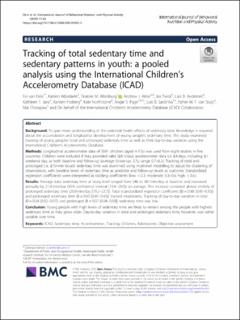| dc.contributor.author | van Ekris, Evi | |
| dc.contributor.author | Wijndaele, Katrien | |
| dc.contributor.author | Altenburg, Teatske M. | |
| dc.contributor.author | Atkin, Andrew J. | |
| dc.contributor.author | Twisk, Jos | |
| dc.contributor.author | Andersen, Lars Bo | |
| dc.contributor.author | Janz, Kathleen F. | |
| dc.contributor.author | Froberg, Karsten | |
| dc.contributor.author | Northstone, Kate | |
| dc.contributor.author | Page, Angie S. | |
| dc.contributor.author | Sardinha, Luis B. | |
| dc.contributor.author | van Sluijs, Esther M.F. | |
| dc.contributor.author | Chinapaw, Mai | |
| dc.date.accessioned | 2021-03-23T09:44:05Z | |
| dc.date.available | 2021-03-23T09:44:05Z | |
| dc.date.created | 2020-12-17T11:53:21Z | |
| dc.date.issued | 2020 | |
| dc.identifier.citation | van Ekris, E., Wijndaele, K., Altenburg, T. M., Atkin, A. J., Twisk, J., Andersen, L. B., . . . Chinapaw, M. (2020). Tracking of total sedentary time and sedentary patterns in youth: a pooled analysis using the International Children’s Accelerometry Database (ICAD). International Journal of Behavioral Nutrition and Physical Activity, 17, 65. | en_US |
| dc.identifier.issn | 1479-5868 | |
| dc.identifier.uri | https://hdl.handle.net/11250/2735001 | |
| dc.description.abstract | Background
To gain more understanding of the potential health effects of sedentary time, knowledge is required about the accumulation and longitudinal development of young people’s sedentary time. This study examined tracking of young peoples’ total and prolonged sedentary time as well as their day-to-day variation using the International Children’s Accelerometry Database.
Methods
Longitudinal accelerometer data of 5991 children (aged 4-17y) was used from eight studies in five countries. Children were included if they provided valid (≥8 h/day) accelerometer data on ≥4 days, including ≥1 weekend day, at both baseline and follow-up (average follow-up: 2.7y; range 0.7–8.2). Tracking of total and prolonged (i.e. ≥10-min bouts) sedentary time was examined using multilevel modelling to adjust for clustering of observations, with baseline levels of sedentary time as predictor and follow-up levels as outcome. Standardized regression coefficients were interpreted as tracking coefficients (low: < 0.3; moderate: 0.3–0.6; high: > 0.6).
Results
Average total sedentary time at study level ranged from 246 to 387 min/day at baseline and increased annually by 21.4 min/day (95% confidence interval [19.6–23.0]) on average. This increase consisted almost entirely of prolonged sedentary time (20.9 min/day [19.2–22.7]). Total (standardized regression coefficient (B) = 0.48 [0.45–0.50]) and prolonged sedentary time (B = 0.43 [0.41–0.45]) tracked moderately. Tracking of day-to-day variation in total (B = 0.04 [0.02–0.07]) and prolonged (B = 0.07 [0.04–0.09]) sedentary time was low.
Conclusion
Young people with high levels of sedentary time are likely to remain among the people with highest sedentary time as they grow older. Day-to-day variation in total and prolonged sedentary time, however, was rather variable over time. | en_US |
| dc.language.iso | eng | en_US |
| dc.publisher | BMC | en_US |
| dc.rights | Navngivelse 4.0 Internasjonal | * |
| dc.rights.uri | http://creativecommons.org/licenses/by/4.0/deed.no | * |
| dc.title | Tracking of total sedentary time and sedentary patterns in youth: a pooled analysis using the International Children’s Accelerometry Database (ICAD) | en_US |
| dc.type | Journal article | en_US |
| dc.type | Peer reviewed | en_US |
| dc.description.version | publishedVersion | en_US |
| dc.rights.holder | © The Author(s). 2020 | en_US |
| dc.source.volume | 17 | en_US |
| dc.source.journal | International Journal of Behavioral Nutrition and Physical Activity | en_US |
| dc.identifier.doi | 10.1186/s12966-020-00960-5 | |
| dc.identifier.cristin | 1860996 | |
| dc.source.articlenumber | 65 | en_US |
| cristin.ispublished | true | |
| cristin.fulltext | original | |
| cristin.qualitycode | 2 | |

